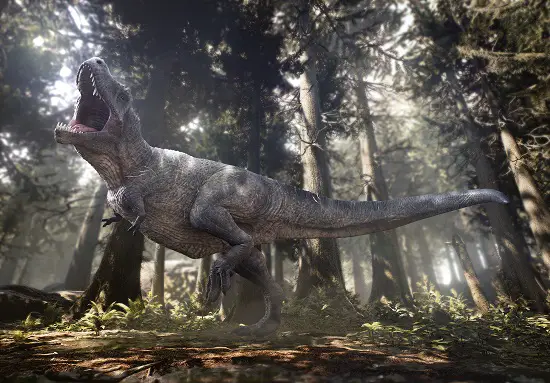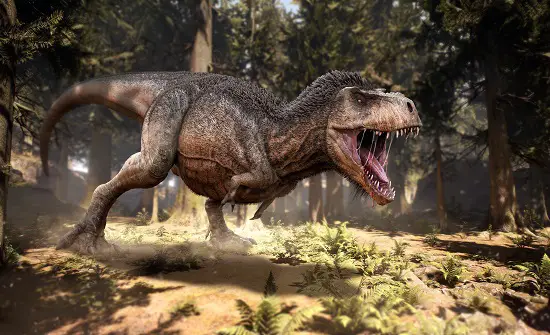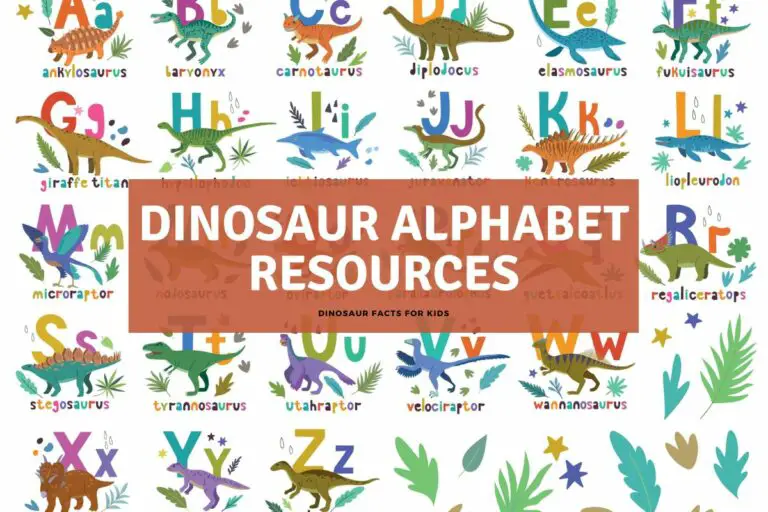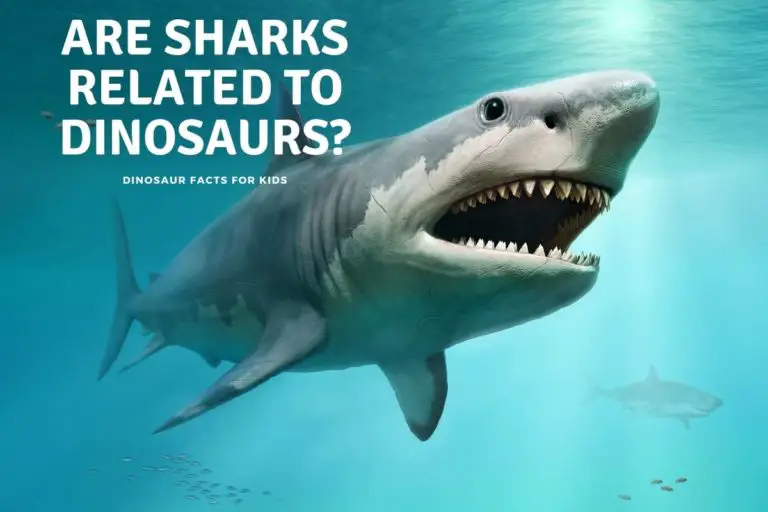How Far Can You Hear a T-rex Roar?
Despite numerous skeletons and fossil discoveries of T-Rex which give us an insight into its impressive size and appearance, understanding dinosaur behavior is much more tricky.
One of these behaviors that is difficult to gauge accurately is the sounds that dinosaurs made. We have been shown T-Rex roaring in defiance in many movies, but how accurate is that, and how far could you hear a T-Rex roar if it did so.
Estimating the T-Rex’s roar range is speculative due to limited direct evidence. However, drawing from current theories and comparisons to modern animals, it’s plausible that a T-Rex’s roar or vocalization, likely a low-frequency sound and not a roar, could potentially travel several miles under optimal conditions.
So while we have become accustomed to thinking that dinosaurs roared, it is currently thought it would have been more likely like a birds “coo” and be it roar or coo we take a look at how far away you could hear it from here in this article.

A Quick Look at T-Rex
The T-Rex, whose name literally means ‘Tyrant Lizard King,’ dominated the landscape of North America some 68 to 66 million years ago during the Late Cretaceous period.
With an estimated length of up to 40 feet and a weight of up to 9-10,000 kg. T-Rex was an apex predator, and arguably the most famous carnivore we have ever had.
But was there an equally impressive roar to go with that size and stature and while sound likely played a role in the T-Rex’s behaviors, from hunting strategies to mate attraction or territorial displays the question on how far its roar would travel, or if it even was capable of roaring are more complex.
Dinosaur Sounds: Current Theories
Sound production in animals is generally linked to specific organs such as vocal cords or syrinx, (a nice straightforward explanation here of a syrinx in birds) but determining whether dinosaurs had similar structures is a complex task.
Fossils typically preserve hard tissues like bones or teeth, while soft tissues seldom fossilize. Hence, direct evidence of sound-producing organs in dinosaurs is virtually nonexistent.
However there have been fossils of prehistoric birds, Vegavis iaai a goose like bird, that was alive at the time of the dinosaurs 68-66 million years ago. Although rare some of these have shown evidence of Syrinx. So the question is if it can fossilize from animals of the same age, why are there none found in dinosaurs.
The answer is probably much more simple than the question. They didn’t have them!
Some scientists propose that dinosaurs, including T-Rex, could produce sounds through a method known as “closed-mouth vocalization.
Many birds, the modern descendants of dinosaurs, use this method, creating sound within their bodies and emitting it through their skin or feathers.

For T-Rex, some suggest it might have created low-frequency, infrasonic sounds similar to those made by elephants. which can travel for miles given the correct conditions.
Others speculate based on the presence of a potential vocal resonance chamber in the T-Rex’s skull. (yeah like that one in Jurassic Park 3) but there is no evidence of these in Non Avian Dinosaurs as research from the Carnegie Museum of Natural History has shown.
Research is ongoing and incredibly complex with the limited fossil evidence available, and it may be a good while yet till we can get an accurate portrayal of what a T-Rex sounded like.
However there have been some suggestions on the sounds a Parasaurolophus with its crest may have sounded like! You can check that out here.
How does sound work?
While we will never claim to be experts on how sound and acoustics work we have a layman’s description on this below.
Sound, essentially a pressure wave generated by vibrating objects, travels through air, water, or solids. The distance it travels depends on factors including its volume, frequency, and environmental conditions.
Louder sounds and those at lower frequencies generally travel further, as they’re less susceptible to energy loss. Meanwhile, environmental factors like temperature, humidity, wind, and obstacles will affect how far sound can travel.
For instance, a sound wave can cover more distance in denser air or when carried by wind.
So to estimate the reach of a T-Rex’s roar, or more probable rumblings. we need to consider not only the roar’s characteristics but also the environmental conditions of the Cretaceous period.
Estimating the Reach of a T-Rex’s Roar
Scientists have attempted to estimate the characteristics and reach of a T-Rex’s roar and sounds.
Based on theories about closed-mouth vocalization the T-Rex’s roar could have been low-frequency, perhaps infrasound, (below the level we can hear) similar to an elephant’s rumble.
Such low-frequency sounds can travel long distances, often several miles, especially if the sound was loud.
The dense and humid environment of the Cretaceous period, as far as we understand it, could have further enhanced the sound’s distance.
With an animal the size of T-Rex it is extremely likely that if it wished to announce its presence to other dinosaurs, it could have done so for miles around, bee that with a roar, a chirp, a coo or a rumble!

Did T-Rex Actually Roar?
While popular culture often portrays the T-Rex with a thunderous, lion-like roar, the reality might have been quite different.
As we’ve discussed, some scientists believe the T-Rex used closed-mouth vocalizations, resulting in a rumble or even a “coo” rather than a conventional roar.
This theory is supported by the fact that many of today’s birds, which are dinosaurs’ closest living relatives, use such vocalizations.
Others speculate that the T-Rex might have hissed, growled, or made booming sounds, based on comparisons with existing reptiles and birds.
All ideas are currently speculative to varying degree, given the lack of direct evidence. We take a more in-depth look at what the actual sounds a T-Rex may have made here and in the article linked here and below.
Comparisons with Modern Animals
there is nothing new when comparing modern animals to dinosaurs to get an idea of body size, eating habits and movement, and these has the potential to also be applied to the sounds dinosaurs made.
Modern animals often guide our interpretations of dinosaur behavior, including the potential reach of a T-Rex’s roar.
- Elephants, for instance, communicate using low-frequency infrasound that travels several miles, indicating that if T-Rex’s sounds or roars were similar, they might have had a comparable reach.
- Lions, famed for their powerful roars, can be heard up to 5 miles away under favorable conditions.
- Some species of whales communicate across astonishing distances, up to 6000km in water, using the properties of underwater sound travel.
So while T-Rex certainly wouldn’t have been able to match a Whale for its sound travel distance, it would have been likely to match the elephant and lion when announcing its presence.
Conclusion
When trying to understand the potential reach of a T-Rex’s roar or probably more accurately its sounds, we have to consider what those sounds may have been first.
A roaring T-Rex could have been heard for miles (as demonstrated in Jurassic Park movies), echoing across miles.
A cooing or rumbling T-Rex, while less dramatic for a movie would have been audible from a long distance as well just like elephants rumblings are today.
However far a T-Rex could be heard from its size and presence would make it hard to miss under any circumstances, whether is was cooing, rumbling or roaring!
References
- https://www.thoughtco.com/how-loud-could-dinosaurs-roar-4070250
- https://www.vox.com/unexplainable/2022/8/24/23318134/dinosaur-roar-science-birds-crocodiles-paleontology
- https://www.sciencealert.com/we-ve-been-imagining-t-rex-roars-all-wrong-study-finds
- https://www.iflscience.com/is-this-what-trex-really-sounded-like-45088
Hi, I am Roy Ford a General Studies and English Teacher who has taught all over the world. What started as a fossil collection became a great way to teach, motivate and inspire students of all ages and all over the world about dinosaurs and from that and children’s love of dinosaurs came the site dinosaur facts for kids, a resource for all ages.







